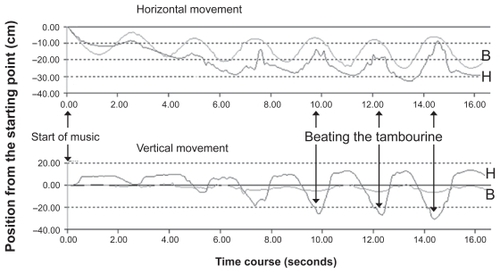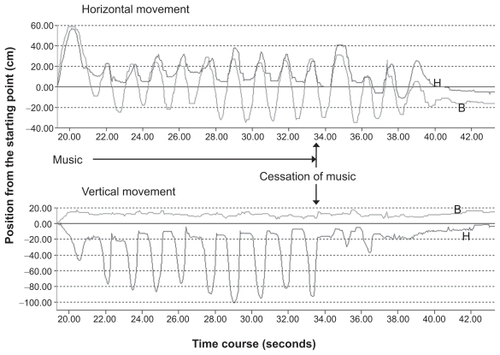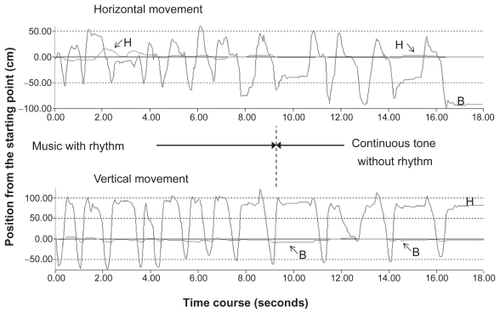Abstract
Patients with Rett syndrome are known to respond well to music irrespective of their physical and verbal disabilities. Therefore, the relationship between auditory rhythm and their behavior was investigated employing a two-dimensional motion analysis system. Ten female patients aged from three to 17 years were included. When music with a simple regular rhythm started, body rocking appeared automatically in a back and forth direction in all four patients who showed the same rocking motion as their stereotyped movement. Through this body rocking, voluntary movement of the hand increased gradually, and finally became sufficient to beat a tambourine. However, the induction of body rocking by music was not observed in the other six patients who did not show stereotyped body rocking in a back and forth direction. When the music stopped suddenly, voluntary movement of the hand disappeared. When the music changed from a simple regular rhythm to a continuous tone without an auditory rhythm, the periodic movement of both the hand and body prolonged. Auditory rhythm shows a close relationship with body movement and facilitates synchronized body movement. This mechanism was demonstrated to be preserved in some patients with Rett syndrome, and stimulation with music could be utilized for their rehabilitation.
Introduction
Rett syndrome is a childhood neurodevelopmental disorder usually caused by a mutation in the gene encoding MECP2 located on the X chromosome (Xq28).Citation1 Rett syndrome occurs predominately in females although males have been described with MECP-2 mutations.Citation2 Stereotyped movement of the hands such as wringing, washing, hand clapping, and hand-to-mouth movements following the loss of the functional use of the hands is the most characteristic feature of Rett syndrome.Citation3 Typically, patients with Rett syndrome have no verbal skills, and about 50% of them are not ambulatory.Citation3 However, they are reported to respond well to music in comparison with their physical and verbal disabilities.Citation4–Citation7
Synchronized movement to music has been observed in all known human cultures, implying that this ability is universal and perhaps unique to human musical behavior.Citation8 Among various musical elements such as pitch, melody, harmony, rhythm, dynamics, timbre, etc., auditory rhythm is known to exhibit a close and fundamental relationship with body movement from early infancy,Citation9,Citation10 and facilitates synchronized body movement not only in healthy subjects of all ages but also in patients with various movement disorders such as Parkinson disease,Citation11 Huntington’s disease,Citation12 stroke,Citation13 and incomplete spinal cord injury.Citation14 Improvement in walking speed and stride length by auditory rhythm was demonstrated in patients with Parkinson disease.Citation15,Citation16 These findings suggest that auditory rhythm could also modify motor behavior and induce voluntary movement in patients with Rett syndrome; however, little is known about the basic role of auditory rhythm in these patients.Citation17
The motion analysis system is a well established clinical method to examine temporal, spatial, and kinetic movements of various parts of the human body, particularly for the assessment of gait in healthy subjectsCitation18 and intervention evaluation in patients with cerebral palsy.Citation19 We utilized this method to investigate the relationship between auditory rhythm and behavioral movement in patients with Rett syndrome in order to promote their voluntary hand movement.
Patients and methods
Ten female patients with Rett syndrome, aged from three to 17 years, were included in this study. The diagnosis was made by more than two child neurologists according to the diagnostic criteria for Rett syndrome established by the Rett Syndrome Diagnostic Criteria Work Group.Citation20 Patient profiles are described in . All patients showed stereotyped hand movement. In addition, eight of 10 patients had stereotyped body rocking movement: back and forth, three; left and right, four; and both, one ().
Table 1 Profiles of patients and movement induced by music
According to the previous study on motion analysis in a patient with Rett syndrome,Citation21 markers were put on the wrists and shoulders in patients to investigate the movement of their hands and upper bodies, respectively. Color tapes 20-mm wide were employed as the markers, and their movements were captured using a two-dimensional digital video camera at a sampling frequency of 30 Hz. Two-dimensional motion analysis software (Move-Tr/2D ver.7; Library Co., Ltd., Japan) was utilized to record temporal, spatial, and kinetic changes of movements in response to music in a qualitative manner.
First, a tambourine was presented in front of patients for several seconds. When no purposeful movement was observed, music familiar to each patient related to us by caregivers was started with a simple regular rhythm. Sometimes, the music was stopped suddenly or changed from a simple regular rhythm to a continuous tone without any rhythm to assess any behavioral changes in movement. This examination was performed after music therapy for six months. Each session was 40 minutes long and was provided once or twice a month.
This study was approved by the Institutional Ethics and Research Board, and informed written consent was obtained from legally authorized representatives of the patients. Participants were outpatients of Saitama General and Medical Center for the Disabled.
Results
When music with a simple regular rhythm started, body rocking appeared automatically in a back and forth direction in all four patients who had the same body movement as their stereotyped movement (). Through this body rocking induced by music, voluntary hand movement increased gradually and finally became sufficient to beat a tambourine presented in front of the patient (). This voluntary hand movement was observed consistently during and after the study when patients were awake and in a good temper. However, the induction of body rocking by music was not observed in the other six patients who did not have stereotyped body rocking in a back and forth direction ().
The motion analysis system demonstrated that body rocking induced by music consisted of primarily repetitive horizontal back and forth movement and little vertical movement (). It persisted with almost the same regular periodic cycle as the auditory rhythm of music and constant amplitude while the music continued (). Through this regular and cyclic body movement induced by music, voluntary hand movement gradually increased in a vertical direction with the same periodic cycle as the body, and finally allowed the patient to reach the tambourine presented in front of her (). Vertical movement of the hand was much more pronounced than horizontal movement of the body (–).
Figure 1 Motion analysis of an 11-year-old patient.

Figure 2 Changes in motion by the abrupt cessation of music in a 7-year-old patient.

Figure 3 Changes in motion induced by music with and without a rhythm in a 12-year-old patient.

When the music stopped suddenly, voluntary movement of the hand soon disappeared (). Horizontal movement of the body also decreased gradually and stopped after a while (). Horizontal movement of the hand merely reflected the accompanying motion of the body in the same direction. When the music changed from a simple regular rhythm to a continuous tone without an auditory rhythm, movements of both the hand and body became slower and the periodic cycle of the motion prolonged ().
Discussion
In this study, patients with Rett syndrome showing stereotyped body rocking in a back and forth direction were demonstrated to recognize and respond well to changes in the rhythm of music. A simple regular auditory rhythm induced stereotyped body rocking movement in a back and forth direction at first. Then, the auditory rhythm as well as induced body rocking movement facilitated voluntary movement of the hands.
Purposeful hand movement was performed through this regular and cyclic body movement induced by music. The target object was placed in front of patients and patients watched it. This might explain why only stereotyped body rocking in a back and forth direction was induced in this study.
Stereotyped movement is repetitive, restricted, and nonfunctional motor behavior observed in various neurological and developmental disorders such as Rett syndrome,Citation3 autistic disorder,Citation22 and visual or auditory impairment.Citation23 If it is frequent and severe, it may interfere with normal voluntary movement. Therefore, treatment and rehabilitation usually focuses on how to suppress it in order to facilitate voluntary movement. However, voluntary movement can be induced more easily through using rather than suppressing stereotyped movement in patients whose voluntary movement is very difficult to promote, such as those with Rett syndrome. The reinforcement of rhythm in stereotyped movement by music might be another way of rehabilitation for such patients.Citation17
Action induction by music is accompanied by neural impulses in the reticular formation of the brainstem.Citation24 In addition, listening to a simple regular rhythm without any actual movement increases the activity of the basal ganglia and supplementary motor area.Citation9 These brain areas are involved in motor prediction and the timing of future movements.Citation25,Citation26 Therefore, listening to music with a simple regular rhythm would prime body movement. This mechanism could be preserved in some patients with Rett syndrome, and stimulation with music might be worth attempting for their rehabilitation. Actually, patients who responded to music showed some improvement of their hand use in everyday life such as opening the door or holding an object for a while even though Rett syndrome progresses with gradual deterioration of the motor system.
In this study, the movement of 10 patients was analyzed in a qualitative manner without a control group. Further studies involving more subjects including older patients with a control group are necessary to clarify the role of auditory rhythm in patients with Rett syndrome.
Acknowledgments
This study was supported in part by The Japan Health Foundation. The authors report no conflicts of interest in this work.
References
- SmeetsEEChenaultMCurfsLMSchrander-StumpelCTFrijnsJPRett syndrome and long-term disorder profileAm J Med Genet A2009149A219920519133691
- JülichKHornDBurfeindPErlerTAuberBA novel MECP2 mutation in a boy with neonatal encephalopathy and facial dysmorphismJ Pediatr2009155114014319559301
- MatijevicTKnezevicJSlavicaMPavelicJRett syndrome: from the gene to the diseaseEur Neurol200961131018948693
- KerrAMArcherHLEvansJCPrescottRJGibbonFPeople with MECP2 mutation-positive Rett disorder who converseJ Intellect Disabil Res200650Pt538639416629931
- WeseckyAMusic therapy for children with Rett syndromeAm J Med Genet Suppl198612532573087187
- YasuharaASugiyamaYMusic therapy for children with Rett syndromeBrain Dev200123Suppl 1S828411738847
- WigramTLawrenceMMusic therapy as a tool for assessing hand use and communicativeness in children with Rett SyndromeBrain Dev200527Suppl 1S959616182499
- BrownSBiomusicology, and three biological paradoxes about musicBull Psychol Arts200341517
- GrahnJABrettMRhythm and beat perception in motor areas of the brainJ Cogn Neurosci200719589390617488212
- ZatorreRJChenJLPenhuneVBWhen the brain plays music: auditory-motor interaction in music perception and productionNat Rev Neurosci20078754755817585307
- McIntoshGCBrownSHRiceRRThautMHRhythmic auditory-motor facilitation of gait patterns in patients with Parkinson’s diseaseJ Neurol Neurosurg Psychiatry199762122269010395
- ThautMHMiltnerRLangeHWHurtCPHoembergVVelocity modulation and rhythmic synchronization of gait in Huntington’s diseaseMov Disord199914580881910495043
- ThautMHLeinsAKRiceRRRhythmic auditory stimulation improves gait more than NDT/Bobath training in near-ambulatory patients early poststroke: a single-blind randomized trialNeurorehabil Neural Repair200721545545917426347
- de l’EtoileSKThe effect of rhythmic auditory stimulation on the gait parameters of patients with incomplete spinal cord injury: an exploratory pilot studyInt J Rehabil Res200831215515718467930
- LimIvan WegenEde GoedeCEffects of external rhythmical cueing on gait in patients with Parkinson’s disease: a systematic reviewClin Rehabil200519769571316250189
- SatohMKuzuharaSTraining in mental singing while walking improves gait disturbance in Parkinson’s disease patientsEur Neurol200860523724318756088
- GoTMedical music therapy based on Baby Science (baby-science-based music therapy) and assistive technology for childrenCurr Pediatr Rev200733198206
- ChesterVLTingleyMBidenENComparison of two normative paediatric gait databasesDyn Med20076817640348
- WestwellMOunpuuSDeLucaPEffects of orthopedic intervention in adolescents and young adults with cerebral palsyGait Posture200930220120619487127
- Diagnostic criteria for Rett syndromeThe Rett Syndrome Diagnostic Criteria Work GroupAnn Neurol19882344254282454607
- WrightMvan der LindenMLKerrAMBurfordBArrowsmithGMiddletonRLMotion analysis of stereotyped hand movements in Rett syndromeJ Intellect Disabil Res200347Pt 2858912542573
- GoldmanSWangCSalgadoMWGreenePEKimMRapinIMotor stereotypies in children with autism and other developmental disordersDev Med Child Neurol2009511303819087102
- GalEDyckMJPassmoreAThe relationship between stereotyped movements and self-injurious behavior in children with developmental disabilitiesRes Dev Disabil200930234235218693081
- MolinariMLeggioMGDe MartinMCerasaAThautMNeurobiology of rhythmic motor entrainmentAnn N Y Acad Sci200399931332114681155
- SardoPRavelSLegalletEApicellaPInfluence of the predicted time of stimuli eliciting movements on responses of tonically active neurons in the monkey striatumEur J Neurosci20001251801181610792457
- RaoSMHarringtonDLHaalandKYBobholzJACoxRWBinderJRDistributed neural systems underlying the timing of movementsJ Neurosci19971714552855359204934